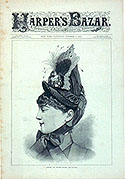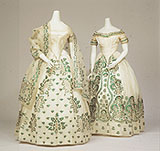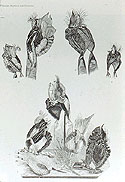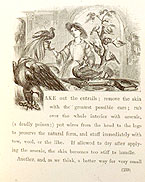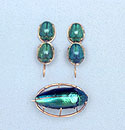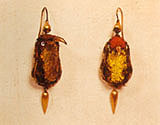The browser will either open the file, download it, or display a dialog.
|
|
"Beetle Abominations" and Birds on Bonnets: Zoological Fantasy in Late-Nineteenth-Century Dress Since we desire to persuade, let us invert the stern moral order |
||||||||
|
Mrs. Haweis alludes to the contemporary inclination toward sartorial excess in her assessment of hats, and, perhaps unwittingly, exposes the tension between ornament and function in stylish dress. In the second half of the nineteenth century fantastic constructions embellished with "beetle abominations" and stuffed birds defied the boundary between "real" nature and fantasy (fig. 1). In these creations, where spectacle and surface displaced form, ornithological and entomological specimens were transformed from animate beings into pure ornament. The proliferation of such adornment in middle-class life belied an increasing disengagement from nature brought about by the industrial revolution and the dramatic changes in urban and suburban living. The conversion of nature into ornament, whether for personal adornment, for exhibitions in the burgeoning natural history museums, or for domestic crafts, ostensibly provided an opportunity for women to reconnect with nature. Yet, as the trend reached its most extreme manifestations, aesthetic reformers and animal preservation activists rejected this literal display of artifice and endorsed absolute stylization and functionality. | ||||||||
| Many fashion theorists and critical thinkers have explored the idea that dress acts as a "vehicle for fantasy" and is a visual manifestation of the movement between the realms of public and private, animate and inanimate, and real and imaginary.2 Women's fashionable dress in the second half of the nineteenth century provides a rich medium in which to explore the movement between these binaries. If clothing can simultaneously express our public and private selves, the taxidermy displays that enhanced home décor, natural history museum installations, and women's bodies resulted in a deep connection between the two. The shift from the animate to the inanimate is played out in the transformation of living animals into ornament. This continuous shifting eventually brings about a third order, that of fantasy, or fashion, which is impelled by the wearing of these zoologically inspired garments and bonnets.3 | |||||||||
|
Theorist Gilles Lipovetsky has argued that within the fashion system "the artificial is not superimposed from without on a preconstituted whole; the artificial henceforth totally redefines forms of dress, both in their essential lines and in their details."4 As we have learned from Mrs. Haweis, this was certainly true of hats of the period, which had lost any reference to their function. Her sentiment is also echoed in the work of Charles Blanc, another author of women's etiquette and beauty manuals, who wrote,
That which was deemed charming from the early 1860s through the 1890s included millinery creations featuring whole, stuffed birds in addition to fanciful creations such as hummingbird earrings and clothing embroidered with iridescent beetle casings. |
|||||||||
|
The earliest form of insect-adorned Western dress derived its inspiration from beetle-embroidered fabric from India imported by England in the 1840s and 1850s (fig. 2). Whereas it may have sparked some interest in the use of beetles as decoration, this type of embellishment appears to have been more of a novelty than a widespread trend. The popular interest in whole, preserved insects and birds as fashionable ornamentation appears to have begun with animal-laden hats and bonnets in Paris in the 1860s, and the style reached its peak in the 1870s and 1880s. In 1863 Godey's Lady's Book, an American periodical for middle-class women, consistently featured hats with trimming that "rivaled nature," including preserved scarabs atop coronets of velvet. Godey's was particularly interested in promoting the "exquisite creations" of Mme. Tilman, whose New York showroom was a branch of a Paris-based business on Rue Richelieu and consequently was at the forefront of fashion trends.6 Her flower, feather, insect, and millinery emporium was described as follows: "Among the beautiful flowers, perfect gems of art . . . we see humming-birds, butterflies and all kinds of brilliant winged insects lighting or seemingly flitting among the beautiful exotics. The birds and butterflies are of course perfect, being the real birds and insects preserved and mounted."7 In October 1863 Godey's revealed that "The ornithological and entomological fevers, which broke out last spring, will continue with increased violence throughout the winter,"8 and the use of stuffed hummingbird trim by Mme. Tilman (the fashion "oracle") was heavily promoted in subsequent issues. Her creations are described as fantastic assemblages of beetles, bird nests, butterflies, flowers, grasses, hummingbirds, and mosses (fig. 3). Rather than subordinating animal parts to the greater design schema, Mme. Tilman used whole animals, preserved in their natural form, as the centerpiece of her constructions. Michael Carter, who posits that the bird ornamentation moves the hats beyond their "brute functionality" into the realm of the imaginary, views these works as potent examples of the true nature of fashion. He describes this shift as "dream-work suddenly being undone."9 | ||||||||
| This movement of nature into the "order of theatricality, seduction and enchanted spectacle" did not, however, exist only in the sartorial realm.10 The notion that nature could be readily transformed into ornament was also demonstrated in the public sphere. People could experience "nature" in the burgeoning public natural history museums, via widely circulating books and periodicals, and through participation in nature-related home recreations, all of which resulted in the popularization of science as a "large scale enterprise."11 Charles Darwin's theories of evolution, first published in 1859, initiated an interest in organizing natural history collections according to his logical, evolutionary taxonomy. His work was so widely disseminated that even periodicals such as Godey's placed Origin of Species by Means of Natural Selection on their recommended reading list. | |||||||||
| More accessible books also proliferated, among them Johnson's Natural History. Published in 1874, Johnson's offered the "great mass of readers" (as opposed to the "scientific naturalist") a comprehensive look at the animal kingdom, "a subject full of poetry as of philosophy, of romance as of reason."12 The novel-like prose and the whimsical illustrations present a sentimentalized view of the animal world. The picture facing the preface, for example, depicts an owl in artist's garb at an easel, painting an image of an elephant. The book was intended to be didactic, however, and is divided into the various animal classes, including the genus and species names, and does present the behavioral patterns of each creature. | |||||||||
| While Johnson's was intended for a general audience, women were the targeted readers of such periodicals as Godey's and Peterson's Magazine, which encouraged them to collect and preserve specimens, participate in horticulture, and create decorative objects from birds, branches, flowers, feathers, insects, and shells. Housewives could adorn their homes with these knickknacks; in the process, they, and their children, learned to appreciate nature. Such craft activity was endorsed as morally and aesthetically uplifting and was deemed appropriate for woman's role as a nurturing, virtuous exemplar.13 The October 1859 issue of Godey's includes instructions for the construction of a "Butterfly Vivarium," described as a "sort of Crystal Palace for butterflies, moths, beetles, dragon-flies, and other members of the entomological division of animated nature."14 The article is illustrated with an image of an ornate ironwork-and-glass container encapsulating an idyllic microcosm of the natural world. This type of miniature terrarium, called the "Ward Case" in Catherine E. Beecher and Harriet Beecher Stowe's widely read American Woman's Home, was recommended for its ornamental and educational purposes. In addition to encouraging children to observe the "beautiful, silent miracles of nature," the Ward Case also helped the housewife avoid feeling like an "utterly disinherited child of nature."15 Beecher thus acknowledged a disconnect from nature and proposed that this tightly controlled and accessible version of the natural world could provide one means of reconciliation. However, like the bird adornment worn on a woman's head, this experience with nature was a construct that shifted "real" nature into the ornamental, domestic realm. | |||||||||
|
In a similar manner, fancywork books such as The Ladies Floral Cabinet and Pictorial Home Companion (1874–81) and Levina Urbino and Henry Day's Art Recreations (published in 1860, 1864 and 1884 and heavily promoted by Godey's) included craft activities that encouraged women to engage directly with objects of nature and to transform them into domestic bric-a-brac. Leaf work, fish scale embroidery, shell work, mosses, cone work, feather flowers, hair work, waxen fruit, and pictures in sand were popular pastimes and featured in numerous publications. Art Recreations also has a short chapter on taxidermy—the accompanying illustration shows a woman in her home amidst stuffed birds, including some perched on a small tree (fig. 4)—in which it briefly describes the taxidermic process, including how to take out the entrails and brains, preserve the carcass with arsenic, and stuff the body with wool or oakum. | ||||||||
| While women usually purchased their bonnets and jewelry with the birds and/or insect bodies in place, their naturalist activities at home required that they purchase or preserve their own specimens. There were numerous dealers of animal specimens, in small and large cities alike, and these businesses often provided taxidermy services in conjunction with refurbishment services for one's millinery trimming. Whereas the instructions in Art Recreations are somewhat cursory, books such as Practical Taxidermy and Home Decoration (1880) provides more detailed instructions. The first half of the book is devoted to the art of disemboweling and preserving animal specimens; the second half offers advice as to how the animals should be displayed. The reader learns that "it is not in good taste to have foreign birds arranged with native ones" and that the birds should show as "much life as possible."16 Practical Taxidermy offers suggestions for mounting insects—displaying them on wax flowers, leatherwork, or fancy grasses, and covering the whole assemblage with a glass dome, for example—and also comprises fancywork projects such as wall decorations that employ moth and beetle bodies to spell out mottoes or to form stars. Thus, in addition to crafting trifles out of mosses and flowers, women were also encouraged to handle, disembowel, and mount animal life. It is not unusual, then, that they felt comfortable adorning their bodies with birds and beetles. | |||||||||
| These somewhat private arenas also have a public dimension, as fashionable women in their bird bonnets visited natural history museums in a desire to learn more about nature, and, perhaps, to view some of the stuffed creatures that adorned their bodies and their homes. The late nineteenth century witnessed unparalleled growth in the number of natural history museums in America and Europe. The American Museum of Natural History in New York opened in 1869 and the Natural History Museum at Kensington opened in 1881. These two institutions were part of a widespread trend that by 1900 had culminated in 250 natural history museums in the United States, 250 in Britain, 300 in France, and 150 in Germany.17 Like the natural science books, these museums were created to satisfy the demand by a growing middle class for an educational way to spend its leisure time. The vast number of visitors to these institutions is evidence of their extreme popularity; by 1900, the American Museum of Natural History was receiving 400,000 visitors annually.18 | |||||||||
|
The nineteenth-century world's fairs also played a role in public awareness of natural history with exhibitions of exotic animal species. Personal adornment embellished with insects and birds was sometimes shown within the context of foreign countries' flora and fauna displays. The Brazil section of the 1873 Universal Exhibition in Vienna, for example, included an impressive display of beetle accessories:
The Brazil pavilion at the 1876 Philadelphia Centennial Exposition also featured beetle-adorned accessories as part of a striking display of artificial flowers made of butterflies, "brilliant insects," and the "gay and brilliant plumage of the birds of Brazil."20 One publication noted that there were several thousand species of beetles exhibited and that "Brazilian ladies have such an admiration for these bright-colored beetles, grand-daddy-longlegs and kindred crawlers that they wear them as brooches, sleeve-buttons and other jewelry, and whole cases of such articles were exhibited here."21 Extant examples indicate that some pieces were assembled in Brazil, whereas others were assembled by local jewelers using Brazilian insects (fig. 5).22 The trend for wearing insects as jewelry appears to have originated in Brazil and was adapted by English, American, and French jewelers. Brazil, with its abundance of diverse beetle species, was the preferred source for the specimens. The trend had taken hold as early as 1872, when a London exhibition featured South American hummingbird and beetle jewelry created by two English firms, Ward & Co. and A. Bouchard. These pieces, described as fashionable, were praised for their outstanding color.23 |
||||||||
| The popularity of this type of jewelry in the 1870s and 1880s is demonstrated by numerous contemporary accounts of it being worn. The fad was prevalent enough for the young Englishwoman Elizabeth Linklater to note, upon seeing Rio de Janeiro for the first time, that "the mountain was very rich in insect life, with the most brilliantly coloured butterflies, and coloured beetles, large and small, including the green variety that I had only seen before set in brooches, earrings, rings, or tie-pins."24 Prior to her trip, personal adornment had been the medium through which Linklater had learned about the beetle world. | |||||||||
| Specific pieces of jewelry appear to have served a similar didactic purpose. Various species of Brazilian beetle collected by George M. Robeson (United States Secretary of the Navy, 1869–77) were set into a parure by the jeweler Ernest Kretzmar of Philadelphia, who kept the shells and heads intact and used gold mounts to create the legs and antennae. The parure—necklace, earrings, brooches, and pins—was exhibited at the 1876 Philadelphia Centennial Exposition. The presence of so many diverse species, with their variously colored and shaped bodies, underscores the fact that, at least to some extent, women so adorned were themselves walking natural history exhibits. | |||||||||
|
The wearers of these items were primarily interested in their aesthetic and fashionable appeal and, in some cases, their extreme novelty. The iridescence of the beetle bodies and the jewel-like tones of hummingbirds were not that easily replicated, however, so the real specimen was considered preferable. In its discussion of the artistic allure of the hummingbird and beetle, Johnson's Natural History notes that the metallic blue of the hummingbird feathers "has caused them often to be called 'flying gems.' Their plumage indeed defies descriptions. The changeableness of the colors, with the movement of these birds is truly wonderful."25 While the book maintains that hummingbirds are "universally beloved," it acknowledges that they were not loved enough to prevent their use as "gems" in necklaces, diadems, earrings, and dress trim (fig. 6).26 Johnson's also uses jewel analogies to describe the attraction of the insect world:
Beetles and birds were appreciated for their aesthetically pleasing qualities, but they were also more affordable than other trimmings. The starlet Lillie Langtry, for example, decorated herself with butterflies instead of gems in the early part of her career when she did not have enough money for expensive clothing:
Although she refers to her whole ensemble as "eccentric," Langtry obviously did not think it unusual to wear preserved butterflies—the insects were readily available and she only had an issue with the impracticality of the garment. |
||||||||
| In a bizarre inversion of the nature/artifice shift, some women actually wore live insects as adornment. The insects traversed the boundary of inanimate ornament, yet their life was preserved. The New York Sun reported the sighting of young women who used live fireflies to embellish their hairdos that "flashed and gleamed and glowed as never diamonds did."29 The story includes an interview with a jeweler who, in an attempt to capitalize upon this trend, was trying to create imitation fireflies in diamonds or diamantes. The jeweler suggested that if only he knew what to feed fireflies, he could enclose live ones in a silver gauze cage and manufacture earrings or hairpins from them. The jeweler also recounted his experimentation with real beetles, which he kept alive until he was ready to mount them.30 It is ornament such as this, the hyper-real, that directly confronted accepted notions of artifice and consequently became the target of intense criticism. | |||||||||
|
|
|||||||||
|
A flourishing and highly profitable trade developed to satisfy the demand for natural history specimens by jewelers, milliners, museums, and private collectors. The number of entomological and ornithological auctions in London began to rise in the 1870s and peaked between 1880 and 1890.31 During this period there was a marked rise in demand for "exotic" and "foreign" beetles, and birds, and butterflies; Africa, the Amazon, Columbia, and India were the regions most singled out for the source of the specimens. To accommodate the caprices of fashion, a rampant international traffic in birds and feathers emerged. According to an 1884 account by a bird skin dealer, it was not unusual to handle approximately 30,000 skins per year.32 The American skins were sold at auction, directly delivered to hat makers, or shipped overseas to Paris- and London-based millinery firms. In 1874 Godey's Lady's Book commented on the wholesale destruction of small birds for use on hats and bonnets in its "Chitchat on Fashion." It specifically mentioned tiny hummingbirds and pondered why women wear them:
The magazine apparently recognized the practice as somewhat barbaric, associating it with a "savage state," yet justified it as simply a fashionable trend. While Godey's had a certain interest in endorsing the whims of fashion, the passage does shed light on the rationale of wearing animal adornment-when nature moved into the realm of whimsical ornament, it simply ceased to be associated with "real" nature. Ironically, Godey's also included articles that seem to reveal a great respect for the biological processes of nature. For example, an 1874 issue featured an excerpt from Popular Science Monthly on the growth of feathers. It is evident that fashionable women knew the origins of their adornment, yet did not associate their hats and dresses with animate beings. Again, once the animal moves into the realm of ornament it is somehow divorced from its origins. |
|||||||||
| The attempt to validate such stylish fancy also extended to natural history theory itself. In The Art of Beauty, Mrs. Haweis utilized Darwinian philosophy to justify zoologically inspired attire. Her book, which addressed numerous fashion, beauty, and etiquette issues, also encompassed a strong dress reform message. Though many of her sartorial standards remained grounded in late Victorian aesthetic ideals, she advocated the banishment of corsets and encouraged simpler dress and examined the idea that women's interest in fashion is a natural, innate inclination. Her reasoning lay in Darwin's theory of natural selection: "In vain have moralists inveighed against our propensity for outward adorning. The need of conspicuousness which Darwin tells us results in the survival of the fittest, is at the root of this love or ornament, a healthy instinct not to be sneered at."34 Darwin's theory of sexual selection refers to a woman's natural appearance rather than superficial embellishment, which Mrs. Haweis found an apt explanation for a healthy interest in adornment. In an era in which the vast majority of women were defined by their roles as wife and mother, the notion that they were to seduce a potential mate with their beauty, and their artifice, was deeply entrenched. Not only was it acceptable to wear dead, stuffed animals on one's body, it was a thoroughly justifiable prerogative for any woman. | |||||||||
|
Although Mrs. Haweis encouraged a "healthy" approach to ornament, her book does mark a change in the attitude toward using real animals on dresses and bonnets. The aesthetic movement, animal preservation movements, and changes in scientific approach in the latter half of the nineteenth century led to the advent of the rejection of zoological finery. While she recognizes that ornament ultimately displaces function for example, Mrs. Haweis rails against Victorian over-adornment. On insects specifically, she comments that one should not use real animals as "the result would convey a painful sense of instability, fragility and incongruousness . . . a butterfly should always be treated conventionally and in an absolutely different material, such as metal."35 She also mentions specific jewelers, among them Messrs. Phillips of London, who, according to her criteria, produced the best and most appropriate pieces. (She evidently was not aware that the Phillips firm had, in fact, produced beetle jewelry in the early 1870s.) She is most critical of the use of bird and insect embellishment in headdresses, which she describes as cheap and trendy creations:
The Art Journal, which had praised the beetle jewelry of the European expositions, also published a critique of the style in a column, written by Percy Fitzgerald, that ran throughout 1877. Entitled "The Art of Dressing and Being Dressed," the column addressed ideas related to aesthetic reform and the promotion of "good taste." For example, Fitzgerald maintained that contemporary fashion was characterized by adornment as an end in itself, which exhibits a "perpetual protest against common sense." Moreover, he argued that
In referring to issues of taste, the author mentions M. Blanc, "a great philosophical authority on such matters."38 |
|||||||||
| On headdresses, however, Charles Blanc's book Art in Ornament and Dress, diverges from Fitzgerald's column in that he believes the sole function of a hat is to adorn. Fitzgerald believes that hats should be practical and functional, protecting the head from dust and the elements and that bonnets that frame the face are the appropriate complement to a woman's head. Flowers or "snowy leaves" are acceptable fringe for hats, but, "all excess is unmeaning."39 Though evidently aiming for simpler styles, the writer is still attached to Victorian aesthetic sensibilities in the allowance of flowers or leaves as embellishment. Blanc also communicates an ambiguous relationship with simplicity and adornment that is tied to contemporary aesthetic trends. Both appear to be struggling with the same issue—to what degree can ornament take precedence over function? | |||||||||
| It is likely Blanc would agree with Mrs. Haweis in her analysis of the purpose of ornament, for, as mentioned above, he firmly believed that the sole purpose of a hat is to adorn one's head. He writes that feathers are purely ornamental in function, but notes that in those of West Indian birds used in millinery, including the hummingbirds of Brazil, "one cannot fail to see . . . a magnificence which suits but few faces, and only those of a marked character."40 Blanc outlines some standards for dress and was greatly concerned with the means of determining style visually. He also declared too extreme for his taste such objects as battery-operated animated brooches, pins, and hair ornaments in the form of a rabbit playing a drum, a "convulsed butterfly," and a bird with flapping wings.41 For him, real animals were more acceptable than these imitations of nature. Like that which made use of live fireflies, ornament that attempted to move back into the animate realm moved beyond the realm of fashion. | |||||||||
|
Other periodicals began to critique bird and insect ornament as a barbaric practice within the context of aesthetic reform. Art Amateur, in a series entitled "Art in Dress" that was published in 1882, included a special column on the wearing of birds and insects. It quotes a letter from the London Times which expresses horror at women who wear stuffed hummingbirds on hats knowing that they are contributing the potential extinction of these "fairy-like children of the sun."42 The author, believing this practice to be completely devoid of aesthetic merit, likens it to the "wearing of horribly gaudy and glittering insects not only in hats and bonnets but in various parts of dress." She also recounts an occasion when a woman, about to brush a beetle off of a lady's shoulder, was horrified to discover that the insect was sewn onto her ensemble. The column continues in a hyperbolic fashion, predicting a future when
The same column, in 1883, showed "Artistic Jewelry" that included a lifelike grasshopper brooch in oxidized metal. The rules were thus being laid out in aesthetic reform. Like Mrs. Haweis's belief that insects were only appropriate in metal, nature was to be used as inspiration, but never in its real, preserved form. |
|||||||||
|
|
|||||||||
| The disquieting reports that some of the more popular species used on hats faced extinction resulted in the formation of various activist groups in the 1880s and 1890s. In England, the Selbourne Society and the Society for the Protection of Birds were formed. In America, the Audubon Society was formed in 1896 to combat the "traffic in feathers adorning women's hats that . . . cost the lives of millions of our finest birds."44 One Florida hunter revealed that he alone had killed 130,000 birds in one season.45 The literature published by the Audubon Society included firsthand accounts by a feather harvester, who collected egret feathers in Venezuela. He confirmed that the feathers were not gathered from the ground but taken from birds that were shot while in their nests.46 The method of acquiring the feathers and the numbers of birds slaughtered appalled ecologically minded groups. Society women, some of them reformed bird wearers, became active participants in the cause. In England, Princess Alexandra allowed the duchess of Portland, a bird activist, to attach her royal name to a conservation campaign.47 Alexandra's concern obviously did not extend to insects, however, as she herself owned a beetle-wing-embroidered garment of Indian export material that was made into a dress in 1915.48 | |||||||||
| Yet by the turn of the century the fad for realistic animal adornment was in decline. In an interesting turn of events, abstracted insect adornment similar to that of Indian export fabric from the 1840s and 1850s would have been deemed more acceptable than the use of whole insects. In the spirit of aesthetic reform, and the subsequent ascendancy of Art Nouveau, realistic depictions of flora and fauna were discarded in favor of stylized images of nature. M. P. Verneuil, for example, devotes his entire book L'animal dans la décoration to the appropriate use of animal motifs in design. His writing, which was excerpted in the July 1898 issue of Art et décoration, states that animals should be used only in a conventionalized way, as absolute realism is why these "villainous beasts . . . frighten nervous women."49 The grasshopper brooch at this point may have been considered too realistic for the new generation of designers. | |||||||||
| Aesthetic reform and its relationship to representations of the natural world also coincided with a change in the nature of scientific inquiry. In the later nineteenth century, an interest in the microscopic began to override the previous interest in the macroscopic. The field of biology was in its nascent stages and the use of photography as documentation began to overtake the collecting of stuffed specimens.50 Mme. Tilman, whose ornithological and entomological wonders were highly praised by Godey's in the 1860s and early 1870s, was out of business by 1884, perhaps a victim of the changing fashion and the animal preservation movement.51 | |||||||||
| The late-nineteenth-century fascination with natural history and its manifestation in dress and personal adornment was the result of various forces: advances in science, industrialization, the rise of the leisure class, and the accessibility of natural specimens, among other things. But the pervasive use of stuffed birds and preserved insects offers insight into the confluence of the real and the imaginary in the creation of fashionable artifice. Women, in negotiating their role in modern society, participated in what Elizabeth Wilson has called a "dream world," in which clothing simultaneously expresses the personal and the private, the animate and inanimate, the ornamental and the functional. The "beetle abominations" and birds on bonnets represented an artificial nature that seemingly reconnected women to real nature, and allowed them to maneuver a fantasy world of their own making. Yet the blatant primacy of ornament—and hence fantasy—over function was ultimately rejected. It is only in the twentieth century that aesthetic reform movements have a lasting impact and temper the extremes of the nature-inspired artifice of the late nineteenth century. | |||||||||
|
1. Haweis 1878, p. 128. 2. Wilson (1985) 1987, p. 12. 3. The author has partially drawn upon Michael Carter's Putting a Face on Things (1997) for a theoretical basis for this paper. 4. Lipovetsky 1994, p. 26. 5. Blanc 1877, p. 112. 6. "Chitchat" April 1863. 7. Ibid. 8. "Chitchat" October 1863. 9. Carter 1997, p. 136. 10. Lipovetsky 1994, p. 26. 11. Drouin and Bensaude-Vincent 1996, p. 408. 12. Johnson's Natural History 1874, p. v. 13. Drouin and Bensaude-Vincent 1996, p. 417. 14. Godey's Lady's Book 59 (October 1859), pp. 310-11. 15. Beecher and Stowe (1869) 1994, p. 102. 16. Batty 1880, p. 147. 17. Sheets-Pyenson 1988, p. 9. 18. Ibid., p. 95. 19. Art Journal 7 (1873), p. 345. 20. McCabe 1876, p. 456. 21. Ingram 1876, p. 501. 22. The author examined examples from the Peabody Essex Museum, Salem, Mass., and some had their provenance noted. 23. Bury 1991, p. 372. 24. Linklater 1938, p. 124. 25. Johnson's Natural History 1874, p. 103. 26. Ibid., p. 105. 27. Ibid., p. 534. While these seemingly innocent analogies might not have been referring specifically to the use of insects as ornament, the author does articulate the visual appeal of these creatures. 28. Langtry 1925, pp. 137-38. 29. "Animals in Jewelry" 1881. 30. Ibid. 31. Chalmers-Hunt 1976, pp. 7-8. 32. Weed 1898, p. 213. 33. "Chitchat" December 1874. 34. Haweis 1878, p. 98. 35. Ibid., p. 99. 36. Ibid., pp. 163-64. 37. Fitzgerald 1877, p. 316. 38. Ibid., p. 318. 39. Ibid., p. 346. 40. Blanc 1877, p. 113. 41. Ibid., p. 256. 42. "Art in Dress" 1882. 43. Ibid. 44. T. Gilbert Pearson, National Audubon Society pamphlet, n.d., Peabody Essex Museum, Natural History Department, Audubon Society file. 45. Kastner 1994, p. 97. 46. Letter to Mr. T. Gilbert Pearson, in "Confessions of a Plume Hunter," Audubon Society pamphlet, n.d. Peabody Essex Museum. 47. Kastner 1994, p. 103. 48. The author viewed this dress at the Costume Institute, Metropolitan Museum of Art, New York. 49. Verneuil 1897, p. ii. 50. Sheets-Pyenson 1988, p. 101. 51. Information taken from Trow's New York City Directory. The business is first listed in 1857 and seems to have peaked in 1875, with three New York locations. By 1880 the company is listed in Brooklyn, and in 1883, the last year it is listed, the millinery business appears to have been run by another family member. |


